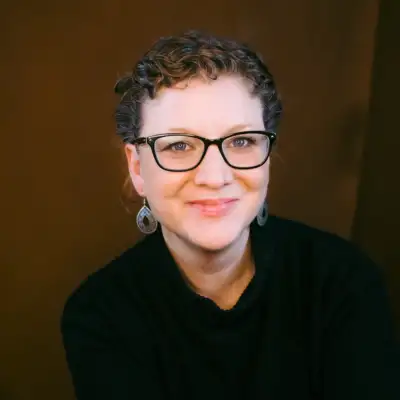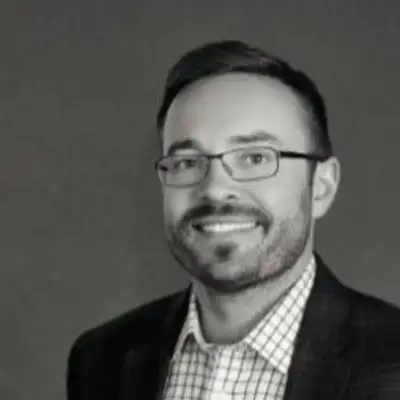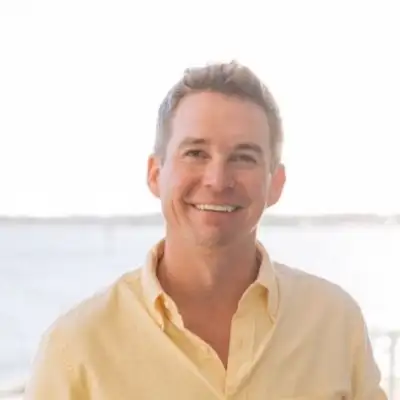Navigating Net Zero: Patrick Flynn & Insights from Salesforce and Beyond
Alexia Kelly: Welcome to Navigating Net Zero. I’m absolutely delighted to be here with sustainability leader Patrick Flynn. Patrick, thank you so much for joining me today.
Patrick Flynn: Thanks, Alexia. I’m so excited to be here and looking forward to the conversation.
Alexia Kelly: The purpose of this podcast is to create space to talk honestly about what’s working, what’s not, and what’s next on the corporate journey to net zero. We’re at a pivotal moment for the climate fight and for democracy.
I’d love to reflect with you on how we can navigate this moment together and to hear about your experiences driving sustainability inside corporate America. To start, can you tell me about your role at Salesforce and what that was like?
Patrick Flynn: I joined Salesforce as Head of Sustainability in 2015. Before that, I led sustainability for a data center company, worked in clean tech investing, and started my career in green building engineering.
By the time I arrived at Salesforce, my north star was clear: maximum impact on climate change. I thought of myself as working for Planet Earth, employed by Salesforce. My job was to light up the company and pull on every lever possible to meet the planetary emergency we faced.
I held that role for about seven years. Since then, I’ve been working more independently, trying to connect the dots among the business world’s most influential climate leaders through an organization I started called Switchboard.
Alexia Kelly: We’ll come back to Switchboard. But first—looking back at Salesforce, what surprised you most about driving sustainability outcomes in such a big company?
Patrick Flynn: At the data center company, many environmental wins made strong financial sense. Energy efficiency, higher utilization of assets, clean energy, storage—all of it was good for business. That experience taught me to talk like a finance person.
Another big lesson was how powerful customer voice can be. We were the largest electricity consumer on our Arizona utility, and that leverage helped us push through a first-of-its-kind clean energy tariff for data centers.
So when I came to Salesforce, I knew how strong the customer voice could be with suppliers, utilities, cloud providers, and real estate providers. But what surprised me was the cultural buy-in. I expected to have to persuade executives that climate change is real and that climate action makes business sense.
Instead, meeting after meeting, I’d get, “We know. That’s why you’re here. How can I help?”
That optimism was powerful. Salesforce had philanthropy baked in from day one, built on the idea that business is the greatest platform for change. By the time I left, sustainability had become the company’s fifth core value.
When people asked me how many people were on the sustainability team, I’d say “80,000.” Everyone at the company, in every role, saw sustainability as part of their job.
Alexia Kelly: How much of that was due to Marc Benioff’s personal commitment? I often point to Salesforce and Microsoft as two U.S. companies where the CEO truly cares about sustainability, in a way most don’t.
Patrick Flynn: Marc Benioff and the founding team deserve a lot of credit. When a company is small, its culture is malleable. As it grows, people join—or stay—because of those values.
That inertia made sustainability deeply embedded. By the time I left, it wasn’t just an initiative, it was part of the company’s DNA.
Alexia Kelly: What are you most proud of from your time in that role?
Patrick Flynn: We achieved a lot. We set ambitious climate commitments, required suppliers to integrate climate into purchasing agreements, helped customers use Salesforce software to manage their climate strategies, and made sustainability a core company value.
But the biggest accomplishment was showing people their jobs were climate jobs. Whether in procurement, legal, or product development, everyone had superpowers they could bring to the climate fight.
Lighting up the whole company in that way was what I’m most proud of.
Alexia Kelly: I can relate. When I was in corporate roles, I was struck by how much change management it took—convincing people who’d done things one way for years that there was reason to take a new approach. Often, it wasn’t obvious to them why sustainability mattered to their role.
Patrick Flynn: Exactly. Each initiative was its own journey. Embedding climate in supplier contracts meant working closely with procurement and legal. Launching Net Zero Cloud was another path.
Ultimately, to change a company, you need to change people. The best way is to show them the old path is riskier, or the new path is more rewarding—or both. That’s when you get people moving.
And empathy is crucial. There’s interpersonal empathy—seeing what motivates someone personally. But there’s also professional empathy. A lawyer has different motivations than an engineer. You need to understand their “video game,” the world they’re playing in, and show them how sustainability helps them succeed.
Alexia Kelly: Let’s dive into supplier engagement. How did that evolve?
Patrick Flynn: Salesforce was an early supporter of science-based targets. One of our goals was to engage 60% of suppliers to set their own targets.
When I presented that to our chief procurement officer, I painted two futures: in one, we tried and failed, but at least we gave it a shot; in the other, we succeeded and catalyzed action far beyond Salesforce. That framing made the change exciting instead of intimidating.
We soon embedded climate action into our standard purchasing agreements. The response was overwhelmingly positive—even from suppliers. Some thanked us: “Now we can show our leadership this matters.” Others wanted to be the first to adopt.
We open-sourced the contract language, and many companies used it. That ripple effect was powerful. But it also showed the limits of supplier engagement. Most emissions are upstream. You can’t just push tier-one suppliers. You need to “jetpack” upstream to electricity, fuels, transport, refrigerants. That’s where systemic change happens.
Alexia Kelly: Yes, when I looked across Scope 3 categories in my previous role, none of them were more than 2% individually. The long tail is overwhelming. At some point, you realize it’s not about chasing every paperclip but addressing the factory that makes the paperclips and what powers it.
Patrick Flynn: Exactly. If you go deep into supply chain emissions and re-aggregate, you find it’s the same familiar sources: electricity, transport fuels, natural gas, refrigerants. It’s not hundreds of categories.
And there’s also value in targeting areas others might neglect—trucking, for example. If most companies see it as a low priority, then stepping up there can have outsized impact.
Alexia Kelly: Were there failures or boundaries you hit at Salesforce?
Patrick Flynn: Early on, my boss told me, “We don’t know where ‘no’ is yet. Go find it.” That gave me license to push hard. Sometimes too hard.
I wanted us to move immediately to 100% clean energy and compensate all emissions. That was too far for the moment. We pulled back slightly, but still got there quickly. It was a lesson in timing and patience.
Alexia Kelly: Sometimes in tech, with so much buy-in and willingness to take risks, you could move faster than most companies. But that’s not the norm. In many sectors, if something doesn’t save or make money, it won’t fly.
Patrick Flynn: That’s right. Twenty years ago, we might have imagined a future where every company steadily did its part—3% to 5% emissions reductions each year. But by the time I got to Salesforce, it was clear we needed bold companies to punch above their weight, set precedents, and push supply chains.
Today the urgency is even greater. We need to give ambitious companies every tool possible to move as fast as humanly possible—including in policy.
Alexia Kelly: So let’s talk about markets. What role do market-based mechanisms play?
Patrick Flynn: I think we’re on the brink of a step change. Many companies have cleaned up their own operations and pushed their supply chains. The next step is addressing systemic sources of emissions in supply sheds and regions.
What holds them back is how to get credit for that work. The greenhouse gas protocol and science-based targets don’t provide clear frameworks. So companies stick it in “page three” of their reports: “Here’s what we’re officially reporting, and here’s this other thing we did.”
We need governance systems that let companies get credit for real, additional action—even when it’s indirect, like adding clean energy to the grid or buying sustainable aviation fuel. Markets aren’t optional. They’re essential for scaling decarbonization efficiently.
Alexia Kelly: And in many cases, it’s not just that it doesn’t make sense to do everything onsite—it’s not even possible. We need collective action, and markets help us channel investment where it’s most effective.
Patrick Flynn: Exactly. Some worry that flexibility lets companies avoid the hard stuff. We need to guard against that. But for those doing everything they can, markets are essential tools to go further and faster.
I’m also excited about finance. Companies can use their customer voice with banks, insurers, retirement plan providers. That’s trillions of dollars in capital flows.
We know how to use customer voice to push suppliers—why not financial institutions too?
Alexia Kelly: Yes, I’ve seen how responsive banks are when a Fortune 500 company calls. Moving from blame and shame to real dialogue—“Here’s what we want, how can we do it together?”—can be transformative.
Patrick Flynn: Absolutely. One of the most powerful arguments a CSO can make is: “Our customers are asking for this.” That lights up the sales team. A big deal on the line with sustainability as a condition? Everyone pulls every lever.
Customer voice is still underutilized.
Alexia Kelly: Let’s shift to supporting CSOs. What do they need?
Patrick Flynn: Being a head of sustainability is one of the hardest jobs out there. You’re constantly threading the needle between planetary needs and business constraints. It’s isolating work.
That’s why I started Switchboard: to reduce duplication, connect leaders, and serve up catalytic opportunities. If a well-funded team figures something out, others shouldn’t have to reinvent it.
And companies move in packs. If we strengthen networks and trust, we can move the pack faster.
Alexia Kelly: I’ve seen that too. Companies calibrate against peers, not external benchmarks. Most don’t want to be out front—they’re happy in the middle. But if the pack moves, they’ll move.
Patrick Flynn: Exactly. One CSO even told me their mandate was “to be aggressively in the middle of the pack.” That’s why collective action is so important. With today’s political context, strength in numbers matters.
I often host breakfasts and dinners just to get CSOs in a room together. My goal is for them to leave with each other’s phone numbers, texting each other, sharing ideas. That connective fabric is critical.
Alexia Kelly: It’s true. The work can be lonely. When I joined Netflix, it was my first job surrounded by non-sustainability professionals. They didn’t understand the jargon. It was humbling—and it underscored how important community is for CSOs who are fighting these battles inside their companies.
Patrick Flynn: Exactly. Forget baseball cards—I’d collect trading cards of heads of sustainability. They’re superheroes.
Too often, we personify companies as villains. But the real work is happening inside, by people trying to do the hardest possible thing. They deserve our support.
Alexia Kelly: So what’s next for you?
Patrick Flynn: I’m continuing to grow Switchboard—connecting CSOs, linking them to theories of change, helping them seize catalytic moments.
And I’m launching a masterclass on how to be a great head of sustainability: how to prioritize strategies with the greatest impact, and how to actually deliver change by winning hearts and minds.
Alexia Kelly: Finally—what keeps you up at night, and what gives you hope?
Patrick Flynn: Honestly, the emails I haven’t sent. I have conversations with CSOs and with people outside corporate America who need companies to step in. I see the connections, the introductions, the follow-ups that could accelerate change—and I worry about the ones I haven’t made yet.
What motivates me is the extraordinary opportunity we have. Yes, it can feel like watching a slow-motion train wreck with no brakes. But never before have humans had so much leverage to make a positive impact for all life on Earth.
A ton of carbon avoided today is more valuable than one avoided in ten years. Future generations will look back on 2025 and ask what we did.
I want to have answers that stand the test of time—that I focused on strategies that could scale, and used my unique superpowers to do as much as possible. That’s all the motivation I need.
Alexia Kelly: Patrick, thank you so much for your leadership and for joining me today.
Patrick Flynn: Thank you, Alexia. And thanks for all the work you do.
Creators and Guests




